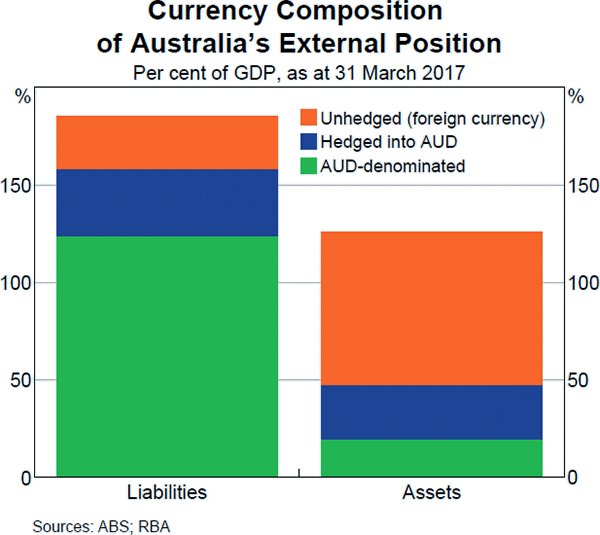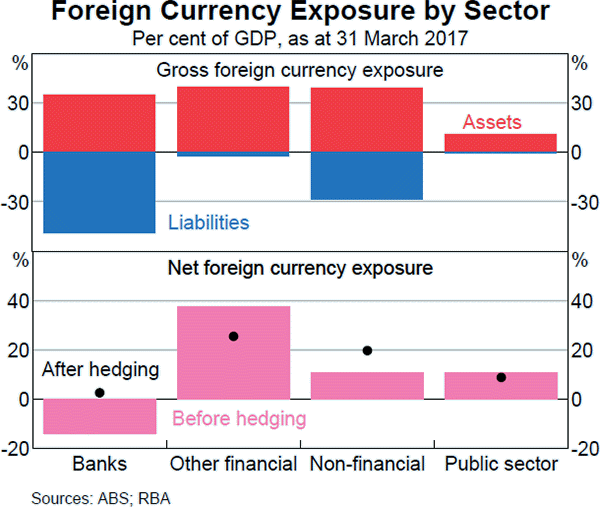Statement on Monetary Policy – November 2017 Box C: Foreign Currency Exposure and Hedging in Australia
Understanding firms' foreign currency exposures and the extent to which these are hedged is important, as these factors could have implications for economic activity and financial stability. Movements in the exchange rate can affect the balance sheet positions and cash flows of firms that hold foreign currency assets or liabilities or conduct trade denominated in foreign currencies. This is particularly important for countries such as Australia that have a net foreign liability position.[1] If a country's liabilities are largely denominated in foreign currency and are not hedged, a large depreciation of the exchange rate will significantly increase the domestic currency value of its external obligations.
Every four years, the Reserve Bank funds the Australian Bureau of Statistics to undertake a survey of firms to better understand the distribution of foreign currency exposures in Australia and the extent to which they are hedged.[2] The latest Survey of Foreign Currency Exposure was conducted as at the end of March 2017 and the results were released recently.[3] It confirmed that, despite the country as a whole having a net foreign liability position equivalent to 59 per cent of GDP, Australia continues to have a net foreign currency asset position even before hedging by derivatives is taken into account. In March 2017, this was equivalent to 45 per cent of GDP (Graph C1). This position reflects the fact that the bulk of foreign liabilities are denominated in Australian dollars, while foreign assets are largely denominated in foreign currencies. Once hedging by derivatives is taken into account, Australia's foreign currency asset position increases to be equivalent to around 50 per cent of GDP. This is because more than half of the foreign currency liabilities are hedged into Australian dollars compared with around one-quarter of foreign currency assets.

The banking sector is fully hedged in net terms and hence has minimal exposure to exchange rate movements. This is important since the foreign currency exposures of the banking system are a potential source of vulnerability. The foreign liabilities of the banking sector account for around one-third of Australia's foreign liabilities and a large share of the country's foreign currency liabilities. The banks hold large foreign currency assets against these foreign currency liabilities; after accounting for its foreign currency asset holdings, the sector had a net foreign currency liability position equivalent to 14 per cent of GDP, or 7 per cent of banks' total financial assets (Graph C2). The exposure to exchange rate movements for the sector as a whole from these positions is minimal because:

- Banks use derivatives to hedge almost 70 per cent of their foreign currency liabilities and around 50 per cent of their foreign currency assets. Hence, in net terms the banks have a small foreign currency asset position after accounting for the use of derivatives for hedging purposes.
- For debt security liabilities – which account for just over half of banks' foreign currency liabilities – the banks are almost fully hedged with derivatives. Moreover, the survey shows that the maturities of the derivatives used to hedge against foreign currency risk are well matched to the maturity of the underlying debt securities.
- For the relatively modest portion of foreign currency liabilities that are not hedged with derivatives, there is typically a matching asset in the same foreign currency. Over recent years, banks have increased their foreign currency deposits that are not hedged with derivatives, but these have been matched by increased lending in the same foreign currency.
Outside of the banking sector, no other sectors had a net foreign currency liability position, either before or after accounting for hedging by derivatives. Among Australian entities, other financial corporations had the largest net foreign currency asset position, in line with this sector capturing large investors in overseas assets such as superannuation funds and fund managers.
Most of the foreign currency liabilities of non-financial corporations, such as mining firms, are not generally hedged with derivatives because these firms tend to have foreign currency income streams. In contrast, the public sector has minimal foreign currency liabilities, almost all of which are hedged.
Footnotes
See ABS (2017), ‘Balance of Payments and International Investment Position, Australia, Mar 2017’, ABS Cat No 5302.0. [1]
For a discussion of the results of the March 2013 survey, see Rush A, D Sadeghian and M Wright (2013), ‘Foreign Currency Exposure and Hedging in Australia’, RBA Bulletin, December, pp 49–57. [2]
See ABS (2017), ‘Foreign Currency Exposure, Australia, March Quarter 2017’, ABS Cat No 5308.0. A more detailed discussion will be included in the Reserve Bank's December 2017 Bulletin. [3]